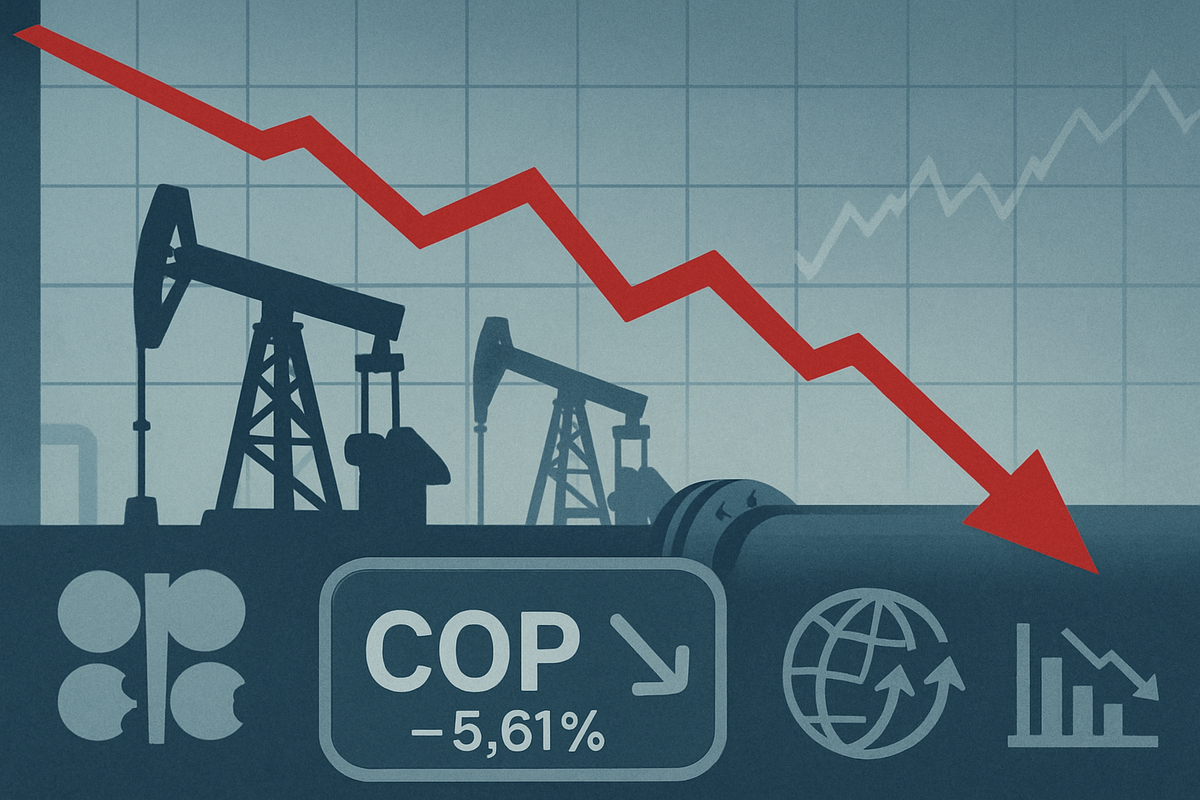Energy Sector Reels as OPEC+ Speculation and EPS Woes Drive ConocoPhillips Decline

New York, NY – September 29, 2025 – The energy sector faced significant headwinds today, emerging as the worst-performing segment in the S&P 500. This downturn was largely spearheaded by a notable slide in ConocoPhillips (NYSE: COP) shares, as market participants grappled with fresh speculation about OPEC+ potentially increasing crude oil output and the company's persistent year-over-year decline in adjusted earnings per share (EPS). The broader market, in contrast, managed modest gains, highlighting the concentrated pressure on energy stocks.
The S&P 500 Energy Sector experienced a substantial 1.9% decline, making it the day's biggest loser. This sharp contraction was exacerbated by a nearly 4% drop in West Texas Intermediate (WTI) crude oil futures, which settled around $63.20 per barrel. Investors are increasingly wary of a potential oversupply in the global oil market, a sentiment fueled by recent developments from the OPEC+ alliance.
Detailed Coverage: A Perfect Storm for Energy Bears
The immediate catalyst for today's market reaction stems from mounting speculation that OPEC+ is poised to approve another oil production increase of at least 137,000 barrels per day (bpd) for November 2025. This decision is anticipated at their upcoming meeting on October 5th, following a similar increase for October. The strategic shift by OPEC+ appears to prioritize market share, aiming to stabilize supply and respond to various pressures. Reports suggest reasons for this include a desire to regain market share, political pressure to lower oil prices, and a response to recent increases in oil prices partly due to Ukrainian drone attacks on Russian energy infrastructure. The group is also methodically unwinding voluntary production cuts totaling 2.2 million bpd implemented in late 2023 and early 2024.
ConocoPhillips (NYSE: COP), a major independent exploration and production company, found itself at the epicenter of this downturn, with its shares plunging by over 3% today. The company’s vulnerability to fluctuating oil prices is well-documented, and the prospect of increased supply directly threatens its revenue and profitability. Compounding this market-wide concern for ConocoPhillips is a persistent year-over-year decline in its adjusted EPS. The company has reported several quarters of declining adjusted EPS, including a drop to $1.42 per share in Q2 2025 from $1.98 in Q2 2024. These declines have primarily been attributed to lower realized prices for oil and gas, alongside increased operating costs and depreciation, depletion, and amortization (DD&A). For instance, in Q2 2025, the company's average realized price fell 19% year-over-year.
Adding to the bearish sentiment, the recent resumption of crude oil exports from Iraq’s Kurdistan region via Turkey further fueled fears of an impending oil glut. This additional supply, estimated to be around 190,000 bpd with potential to reach 500,000 bpd, is seen as another factor contributing to the downward pressure on oil prices. The collective impact of these factors—OPEC+ supply speculation, ConocoPhillips' internal earnings challenges, and broader supply increases—created a perfect storm for the energy sector on September 29, 2025.
Company Impact: Who Wins and Who Loses in a Softening Market
The anticipated downturn in oil prices, primarily driven by increased OPEC+ supply, is expected to create a clear divide between winners and losers across the public energy sector. Exploration and production (E&P) companies, like ConocoPhillips (NYSE: COP), are particularly vulnerable. Their revenues and profitability are directly tied to crude oil prices, meaning lower prices translate to reduced cash flows and compressed profit margins. Companies with higher breakeven costs and significant debt loads will face increased financial strain.
Beyond ConocoPhillips, other prominent E&P players such as Diamondback Energy (NASDAQ: FANG), Devon Energy (NYSE: DVN), EOG Resources (NYSE: EOG), Occidental Petroleum (NYSE: OXY), and APA Corporation (NASDAQ: APA) are likely to experience similar pressures. These companies, heavily invested in U.S. shale plays, will see their drilling activity and capital expenditures scaled back in a lower price environment. Oil services companies, which provide essential equipment and support for drilling and production, will also feel the pinch. Firms like Halliburton (NYSE: HAL), Baker Hughes (NASDAQ: BKR), and NOV (NYSE: NOV) face reduced demand for their services and increased pricing pressure as E&P clients cut back.
Conversely, integrated oil majors with diversified portfolios and strong balance sheets are better positioned to weather the storm. Companies such as ExxonMobil (NYSE: XOM) and Chevron (NYSE: CVX), with robust downstream (refining and marketing) and chemical operations, can often benefit from lower crude input costs, which can boost refining margins if product prices remain stable. Similarly, European majors like TotalEnergies (NYSE: TTE) and Shell (NYSE: SHEL), with their expanding renewable energy segments, offer a degree of hedging against oil price volatility. Refining companies like Marathon Petroleum Corp (NYSE: MPC) and Valero Energy (NYSE: VLO) might also see improved cracking margins from cheaper feedstock, though sharp price declines can lead to inventory losses. Additionally, E&P companies with exceptionally low production costs, such as Coterra Energy (NYSE: CTRA), or those primarily focused on natural gas, like Mach Natural Resources (NYSE: MNR), may find relative resilience if natural gas demand remains strong.
Wider Significance: Navigating a Complex Energy Landscape
This event fits into a broader industry trend of increasing market volatility, driven by a complex interplay of supply-side adjustments, evolving global demand, and an accelerating energy transition. The OPEC+ decision to increase output underscores a strategic shift towards reclaiming market share, a move that could reshape global oil trade flows and pricing power. This action also highlights the delicate balance between managing global supply for price stability and responding to political pressures for lower energy costs.
Geopolitical factors continue to cast a long shadow over the energy markets. Ongoing conflicts in Ukraine and the Middle East, coupled with rising trade protectionism and strategic decoupling efforts between major economies like the US and China, contribute to supply chain vulnerabilities and heightened risk premiums. While these conflicts have caused temporary fluctuations, the global energy system has shown resilience, absorbing shocks without major supply disruptions, a testament to a more diversified, albeit still vulnerable, market.
From a regulatory and policy perspective, sustained lower oil prices could offer a reprieve from energy inflation, potentially reducing transportation and manufacturing costs in major economies. However, it might also reduce the immediate political urgency for some nations to accelerate their energy transition, particularly if energy security concerns prioritize affordable fossil fuels. Conversely, it could free up capital for other investments. Historically, periods of oil oversupply have consistently led to sharp price declines, impacting producers and stimulating demand, a pattern that appears to be unfolding for late 2025 and early 2026. The simultaneous growth of both fossil fuels and renewables, described as a "disorderly energy transition," mirrors historical phases where new energy sources emerged alongside existing ones rather than immediately replacing them.
What Comes Next: A Path Through Uncertainty
In the short term (late 2025 to early 2026), the market is bracing for continued downward pressure on crude oil prices. The U.S. Energy Information Administration (EIA) projects Brent crude to average $59 per barrel in Q4 2025, potentially falling to around $50 per barrel in early 2026, driven by anticipated large oil inventory builds. This environment will necessitate strategic pivots for energy companies. Cost efficiency and disciplined capital allocation will be paramount. A shift towards natural gas-intensive drilling regions is expected in the United States, as natural gas is increasingly viewed as a critical transitional fuel, especially with rising demand from AI data centers and U.S. LNG exports.
Longer-term, the outlook remains complex. While sustained oversupply could keep prices subdued, potential under-delivery by some OPEC+ members due to capacity constraints, or unforeseen geopolitical supply disruptions, could lead to price rallies, particularly if upstream investments fail to keep pace with demand. Energy companies will need to diversify into energy transition technologies, allocating capital to solar developers, battery manufacturers, and grid infrastructure firms to hedge against oil's cyclical nature. Resilience, rather than pure dominance, will define success in the coming decade, with a focus on hybrid models combining renewables, storage, and smart grid technologies.
Potential market opportunities lie in the growing demand for natural gas and LNG, especially with West Coast LNG expansion. Energy infrastructure companies (Master Limited Partnerships - MLPs) could offer stable cash flows. Investment in renewables, storage, and smart grid technologies will remain crucial, driven by global carbon neutrality commitments. However, challenges include the overarching risk of global oversupply, slowing demand growth in key regions, and persistent geopolitical risks. Investors should prepare for a baseline scenario where Brent crude stabilizes in the $60-65 range by year-end 2025, a bearish scenario pushing prices to $50-55 by early 2026, or a bullish scenario where supply disruptions maintain prices above $70.
Wrap-Up: Navigating a Dynamic and Challenging Market
Today's weak performance in the energy sector, particularly the decline of ConocoPhillips (NYSE: COP), serves as a stark reminder of the volatile forces shaping the global oil market. The interplay of OPEC+ supply decisions, company-specific earnings challenges, and broader macroeconomic and geopolitical trends creates a challenging environment for traditional oil and gas producers. The key takeaways are clear: increased oil supply is likely to put downward pressure on crude prices in the near term, and energy companies must prioritize financial discipline and strategic diversification.
Moving forward, the market will be characterized by a delicate balance between supply and demand, heavily influenced by OPEC+'s actions and global economic health. Investors should closely monitor OPEC+ compliance rates, global oil demand trends (especially from emerging markets), and inventory levels, as these will be critical indicators of price direction. Geopolitical developments, central bank rhetoric, and shifts in trade policy will also continue to introduce significant volatility. Companies with strong balance sheets, operational efficiency, and a clear strategy for navigating both traditional and transitional energy markets, particularly those embracing natural gas and renewables, are likely to prove more resilient.
The current landscape underscores the need for a diversified and agile investment strategy. While the immediate outlook for crude oil prices appears challenging due to anticipated oversupply, the long-term energy transition and evolving geopolitical landscape present both risks and opportunities. What investors should watch for in the coming months are not just the headline oil prices, but the underlying shifts in energy policy, technological advancements, and the strategic adaptations of industry leaders.
This content is intended for informational purposes only and is not financial advice.
More News
View More




Recent Quotes
View More
Quotes delayed at least 20 minutes.
By accessing this page, you agree to the Privacy Policy and Terms Of Service.